2 Chemical Weapons
By Captain John-Paul Hood, US Army
Student Objectives
The student will be introduced to recent employments of chemical weapons within the last ten years and discover how they can be retrofitted for delivery by drone.
Introduction:
Case Study 1: The Potential for Chemical Weapons Release in Ukraine
There is a “real threat” of Russia using chemical weapons in Ukraine, President Joe Biden said Wednesday before flying to Brussels to meet with leaders about stopping Moscow’s war. (Feldscher, 2022)
Russia has spent weeks falsely claiming that Ukraine is working on chemical and biological weapons programs funded by the United States. Even though the Soviet Union has been making unfounded allegations about the American use of biological weapons since 1949, Russian officials recently brought the claims to the UN Security Council and have attempted to justify the invasion of Ukraine as necessary to stop this alleged research. (Feldscher, 2022)
Figure 2.1 Soldiers in Mission Oriented Protective Posture (MOPP) Gear
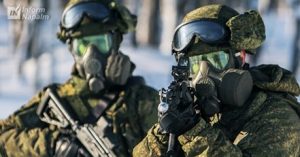
Source: (Inform Napalm, 2022)
That rhetoric from Russia makes officials worry that a biological or chemical weapons attack could be on the way because it fits a pattern in which Moscow blames Ukraine or the West for something before taking that same action itself. (Feldscher, 2022)
“The main thing we’re looking at right now is the deliberate drumbeat of misinformation and propaganda and lies on this subject that has all the markers of a precursor to them using these weapons,” National Security Advisor Jake Sullivan said Wednesday at a briefing. He declined to comment on whether intelligence showed Russia moving chemical or biological weapons into position to use. (Feldscher, 2022)
Even if it does not use chemical weapons, Russia has already committed brutal attacks in Ukraine, including targeting a shelter marked as having children inside and bombing a maternity hospital. On Wednesday, Secretary of State Antony Blinken said an investigation found that Russia’s troops have committed war crimes in Ukraine. (Feldscher, 2022)
Russia is also suffering significant casualties in the conflict, making troops more desperate to use all possible tools to stop the losses. A NATO military officer said Wednesday that between 30,000 and 40,000 Russian troops had been harmed, including between 7,000 and 15,000 killed, the Associated Press reported. (Feldscher, 2022)
Before Moscow’s invasion began on Feb. 24, the administration repeatedly highlighted how Russia’s playbook often includes so-called “false flag” operations, spreading misinformation about Ukraine and the United States to argue that Russia had to defend itself and attack Ukraine.
“What worries us about those types of statements or accusations is they may be again laying…a pretext for them to do something more or much worse inside Ukraine,” Julianne Smith, the U.S. permanent representative to NATO, said Wednesday at an Atlantic Council event. “We’ve been warning allies about this. We’ve been warning the Ukrainians. We’ve issued warnings to Russia.” (Feldscher, 2022)
Ned Price, the State Department spokesman, said on March 9 that Russia is spreading “outright lies” and confirmed that the United States does not own or operate any chemical or biological weapons labs in Ukraine. (Feldscher, 2022)
At the NATO Summit on Thursday, leaders are expected to approve additional military assistance for Ukraine, including equipment to protect Ukrainians against chemical and biological weapons, NATO leader Jens Stoltenberg said Wednesday. Stoltenberg also strongly urged Russia not to use these types of weapons in the fight, saying he is “concerned” by Russia’s statements on chemical weapons use. (Feldscher, 2022)
“Any use of chemical weapons would totally change the nature of the conflict and be a blatant violation of international law and will have far-reaching consequences,” he said at a press conference. “We are also concerned because we know that Russia has used chemical agents before, and they have supported Assad and facilitated the use of chemical weapons in Syria.”
More than 300 chemical attacks were launched during the Syrian Civil War, NPR reported in 2019. American officials accused Russia of helping Syrian President Bashar al-Assad’s regime cover up these attacks, but Russian officials denied using chemical weapons. Instead, Russians claimed that the event was staged, and the West used the findings to justify taking military action, Reuters reported. (Feldscher, 2022)
On March 11, Biden also promised Russia would pay a “severe price” if it deployed chemical weapons in Ukraine. A biological, chemical, or nuclear weapons attack in Ukraine could trigger a response from NATO if the fallout from the attack drifted into a neighboring member of the alliance and impacted people there. At a Defense Writers Group event, Sen. Jack Reed, D-R.I., said Wednesday. (Feldscher, 2022)
“It would all be viewed through the lens of, is this an attack against a NATO country?” he said. “If a nuclear device is detonated and the radiation goes into an adjacent country, that could be perceived as an attack against NATO….It will be a very difficult call, but it’s a call that the president and the entire NATO council will have to make.” (Feldscher, 2022)
Case Study 2: Chemical Weapons Release in Syria and the Organization for the Prohibition of Chemical Weapons
For much of its early history, the Organization for the Prohibition of Chemical Weapons (OPCW) was a little-known international organization quietly verifying the destruction of Cold War-era stockpiles required by the Chemical Weapons Convention (CWC). Today, the OPCW is the epicenter of a global chemical weapons crisis and a front line in a broader confrontation between the West and Russia. (Ward, 2021)
When the CWC entered into force in 1997, it seemed that all that remained to achieve a world free of chemical weapons was to verifiably destroy declared stockpiles and universalize membership. Instead, the international norm against chemical weapons use is under siege, most prominently by Syria and Russia, two states-parties to that treaty. The world is now precariously perched on the knife’s edge of a new era of chemical weapons use. (Ward, 2021)
Once the chemical weapons crisis erupted in Syria, the OPCW was forced to make a historic transformation, moving from being solely a standard arms control monitoring body to becoming an indispensable instrument of international peace and security, as recognized when the organization was awarded the 2013 Nobel Peace Prize. This new role must be strengthened to address the chemical weapons threat that has metastasized globally due to recent chemical weapons use in the United Kingdom, Russia, Iraq, and Malaysia. (Ward, 2021)
Ghouta: The Ieper of the 21st Century
The hope that chemical weapons use had been consigned to the 20th century was shattered on August 21, 2013, when the Syrian military launched a barrage of rockets filled with the nerve agent sarin against the opposition-controlled town of Ghouta, a suburb of Damascus. Soon afterward, a UN investigation team confirmed the worst: 1,400 people were killed from exposure to sarin. The images of the Ghouta victims were seared into the collective conscience of humanity alongside Ieper, the site of the first major use of chemical weapons in World War I, and Halabja, where Iraqi President Saddam Hussein in 1988 perpetrated a devastating nerve agent attack against the Kurds. (Ward, 2021)
Western powers considered military intervention to deter further carnage as the world reeled in horror from the Ghouta attack. Still, when U.S. Secretary of State John Kerry and Russian Foreign Minister Sergey Lavrov met in Geneva to discuss the crisis on September 14, they achieved a diplomatic breakthrough known as the Joint Framework for the Elimination of Syrian Chemical Weapons. The United States and Russia found common ground on only one point: the Syrian chemical weapons stockpile needed to be removed and destroyed. To this end, Russia tacitly assumed responsibility as the guarantor, ensuring that its Syrian ally would not use chemical weapons and would fully declare its chemical weapons stockpile so it could be destroyed under international oversight. Syria initiated formally joining the CWC just 24 days after the Ghouta attack. During that brief period, the Assad regime had not undergone a moral conversion but bowed to pressure from the Western powers and Russia. (Ward, 2021)
By the end of September 2013, the international community had legally anchored the U.S.-Russian joint framework in a decision of the OPCW Executive Council and in a UN Security Council resolution, which included measures to address any Syrian failure to comply with the resolution’s provisions or with the prohibitions of the CWC. (Ward, 2021)
False Declaration and Chemical Weapons Attacks
In the spring of 2014, while Syria’s declared chemical weapons stocks were being removed from its territory for destruction, the first signs appeared that Damascus did not intend to comply fully with its commitments under the CWC and the UN resolution. The unraveling of the historic joint framework had begun. (Ward, 2021)
Widespread reports emerged of chemical weapons attacks involving chlorine gas barrel bombs dropped by helicopters on opposition-controlled towns, resulting in injuries and fatalities. The claims prompted the OPCW director-general to establish a fact-finding mission, which later determined that chlorine had been used as a weapon in Syria repeatedly and systematically from April to August 2014. (Ward, 2021)
Figure 2.2 Civil Defense member carries a damaged canister in Ibleen village.
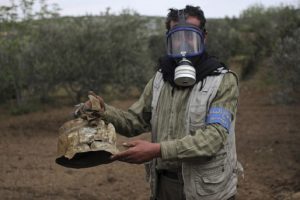
Source: REUTERS/Abed Kontar/File Photo (Anthony Deutsch, 2018)
A Civil Defense member carries a damaged canister in Ibleen village from what activists said was a chlorine gas attack on Kansafra, Ibleen, and Josef villages, Idlib countryside, Syria, May 3, 2015.
During that same period, there were indications that Syria had not fully disclosed its chemical weapons program in its October 2013 declaration to the OPCW. The OPCW Technical Secretariat, after a detailed examination of the declaration and site visits in Syria, identified troubling discrepancies, prompting the organization’s director-general to establish a dedicated group, the Declaration Assessment Team, to continue engagement with Syrian authorities until the declaration could be fully verified as accurate and complete. That group has conducted more than 20 rounds of consultations with Syria, yet 19 issues remain unresolved. (Ward, 2021)
Renewed concern over chemical weapons uses in Syria prompted the adoption of another UN resolution in which the Security Council unanimously established the OPCW-UN Joint Investigative Mechanism (JIM). Since the fact-finding mission mandate was limited to determining only whether chemical weapons use occurred in Syria, the JIM was established as a panel of experts to identify those individuals, groups, or governments involved in their use. In the fall of 2016, the JIM reported its findings, concluding that the Syrian military had been involved in using toxic chemicals (chlorine gas) as weapons in three attacks in 2014 and 2015. (Ward, 2021)
Although Moscow refused to accept the JIM’s findings that its Syrian ally was using chemical weapons in violation of the CWC and the Security Council resolution, it begrudgingly agreed in November 2016 to renew the JIM’s mandate for another year and endorsed a new panel of experts to lead the effort. Within months, the JIM would become seized with the most devastating chemical weapons attack since Ghouta. On April 4, 2017, the Assad regime launched a sarin nerve agent attack against the opposition-controlled town of Khan Shaykhun. Damascus and Moscow quickly flooded the media with disinformation and outright fabrications, claiming the opposition itself had launched the attack to accuse the Assad regime falsely. The United States launched cruise missiles against the Syrian airfield where the attacking aircraft originated to deter further chemical weapons use. (Ward, 2021)
Despite Russian and Syrian efforts to bury the truth of what happened in Khan Shaykhun, the JIM determined that the Syrian military had used sarin in the attack. However, it was evident at the United Nations and the OPCW that Russia would seek to block any international action against its Syrian ally, no matter how damning the evidence. Indeed, it was in direct reaction to the JIM’s competence that Russia vetoed three renewal resolutions at the UN, and the JIM ended in November 2017. (Ward, 2021)
Figure 2.3 Soldier in MOPP Gear Ready
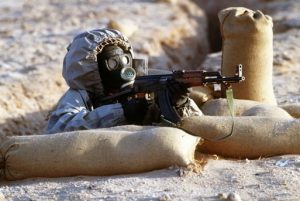
Source: (Stein, 2018)
Deepening Chemical Weapons Crisis
Two chemical weapons attacks in the spring of 2018 escalated the threat to the international norm against the use of chemical weapons. In March, former Russian spy Sergei Skripal, now a UK citizen living in Salisbury, and his daughter were poisoned by a Novichok nerve agent known to have been developed by the Soviet Union. The UK blamed Russia for the assassination attempt, underscoring the terrible risk the use of such a nerve agent had posed to the local community. Indeed, a resident of the adjacent town of Amesbury later died. The UK requested a technical assistance visit by OPCW experts, who confirmed that a nerve agent was used in the attack. (Ward, 2021)
On April 18, 2018, the OPCW Executive Council met to address the experts’ findings. In the wake of the expulsion of Russian diplomats by the UK, the United States, and others, the meeting immediately escalated into high politics, with Russia unleashing absurd counteraccusations and protesting that it was the victim of a Western smear campaign.
(Ward, 2021)
Before the day was over, it was clear that a front line in a broader international confrontation had opened. In addition to the Syrian crisis, there was now an even more ominous Russian problem. Russia was no longer just an enabler of Syria’s use of chemical weapons, protecting it at the OPCW and the UN Security Council; it was itself a perpetrator, signaling to the world that it still illicitly possessed its own dangerous chemical weapons agent. Moreover, Moscow now viewed the OPCW Technical Secretariat as an adversary. Just a week earlier, as reported by the Dutch government, agents from the Russian military intelligence branch, the GRU, were deported from the Netherlands for attempting to conduct cyber operations against OPCW headquarters in The Hague from an adjacent hotel. (Ward, 2021)
As the chemical weapons threat widened to the European continent, the crisis in Syria deepened. On April 7, multiple chlorine-filled barrel bombs were dropped on the Damascus suburb of Douma, killing dozens of civilians. Again, a highly charged special meeting of the OPCW Executive Council was convened on April 16, just two days after joint military strikes against Syrian government facilities by France, the UK, and United States. Russia and Syria falsely claimed that the UK and the United States “staged” the Douma chlorine attacks with the help of the White Helmets, an organization of volunteer first responders in Syria that Russia has tried to label as terrorists. Within weeks, OPCW fact finders went to Douma to further its investigation, concluding that chlorine was used. (Ward, 2021)
The OPCW also faced a grim new reality extending beyond Syrian and Russian transgressions. The Islamic State group had used chemical weapons in Syria and Iraq. Moreover, North Korea, although not a party to the CWC, was advertising its chemical weapons capabilities by assassinating the stepbrother of leader Kim Jong Un with a VX nerve agent in a Malaysian airport.
OPCW Response to Widening Chemical Weapons Use
With the increasing use of chemical weapons undermining the CWC, seriously eroding the international norm, and putting the world at risk of a new era of chemical weapons threats, the OPCW had to act or succumb to irrelevance. (Ward, 2021)
Deeply aggrieved by Russia’s use of chemical weapons on its territory and concerned with a worsening chemical weapons crisis, the UK initiated a special session of CWC states parties to forge an international response. After Russia and Syria tried unsuccessfully to block the adoption of the agenda, the fourth special session of the conference of CWC states-parties on June 27, 2018, with broad international support, took unprecedented steps to address the crisis by adopting the historic decision titled “Addressing the Threat From Chemical Weapons Use.” (Ward, 2021)
Most importantly, the decision dealt with Syria’s continued possession and use of chemical weapons. To remedy the termination of the JIM, the conference directed the OPCW Technical Secretariat to “put in place arrangements to identify the perpetrators of the use of chemical weapons” in Syria. Director-General Fernando Arias implemented that directive by establishing the Investigation and Identification Team, which, in April 2020, found reasonable grounds to conclude that Syria conducted three chemical weapons attacks against opposition-controlled areas in March 2017. In response to these findings, the conference of states-parties in April 2021 suspended Syria’s voting rights at the OPCW. (Ward, 2021)
The decision further clarified the mandate of the OPCW Technical Secretariat in the context of the CWC. If requested by a state party investigating the possible use of chemical weapons on its territory, the director-general was expressly authorized to provide technical expertise to help identify the perpetrators of any chemical weapons attack. (Ward, 2021)
The decision also authorized the release of OPCW information to any entities established under the auspices of the UN investigating chemical weapons use in Syria. This provision would aid the ongoing investigation efforts of two such entities: (1) the International, Impartial, and Independent Mechanism (IIIM) established to assist in the investigation and prosecution of persons responsible for committing war crimes in Syria, and (2) the Independent International Commission of Inquiry on the Syrian Arab Republic. (Ward, 2021)
The Fight for a Future Free of Chemical Weapons
Threats to the CWC and the international norm against chemical weapons remain ominous and unabated, as evidenced by Russia’s attempted assassination of opposition leader Alexei Navalny with a Novichok nerve agent in August 2020. (Ward, 2021)
Russia’s contempt for and repeated violation of the convention are appallingly evident. Moscow has enabled and protected its Syrian ally by relentlessly wielding its veto at the UN Security Council, opposing action by the OPCW, and engaging in a calculated global campaign of disinformation and distortion. In two assassination attempts against opponents, Russia has advertised that it illicitly maintains a chemical weapons program, possesses Novichok nerve agents, and has no compunction about using such outlawed weapons against its adversaries. There should be no expectation that Russia’s contempt for the convention will ebb in the foreseeable future. Indeed, Moscow’s continued embrace of chemical weapons is not an isolated insult but rather part of a much larger challenge to the West. (Ward, 2021)
The Assad regime remains a long-term threat to the convention and the international norm against chemical weapons use. It views chemical weapons as a vital survival tool and a strategic counterweight to Israel. There should be no expectation that Syria will finally comply with its CWC obligations once the conflict is over. Rather, Syria should be expected to seek to produce and deploy chemical weapons as long as the Assad regime remains in power. (Ward, 2021)
Figure 2.4 Mustard gas artillery shells
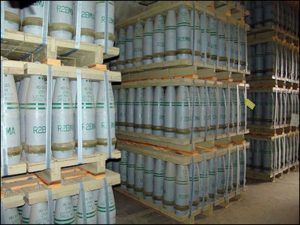
Source: (Details, 2012)
In the fourth special session of the conference of CWC states, parties in June 2018 began an effort to push back against these threats and avoid a return of the chemical weapons horrors of the 20th century. This must continue and intensify as it will be a long-term struggle. (Ward, 2021)
The United States must prioritize defending the CWC and lead an international effort to hold perpetrators accountable in all relevant forums. What would this entail? Chemical weapons used by North Korea and the Islamic State group are sure of concern, but they are not parties to the treaty and thus not a primary factor in the current crisis, which is largely a Russian problem. It is important to recognize that deterring Moscow from possessing or using chemical weapons or enabling their use by others is a challenging task. Increased pressure through sanctions and initiatives at the OPCW and UN General Assembly will continue to play a role. Importantly, the United States and its allies must mount a diplomatic and public messaging campaign to counter Russian disinformation and deprive Moscow of credibility or support. This would include further isolating Russia from the international community by encouraging key states in Africa and Asia sitting on the sidelines to join efforts to condemn chemical weapons use by Syria and Russia. (Ward, 2021)
To be clear, the near-term prospects for deterring further Russian chemical weapons affronts are not favorable. The Russian chemical weapons problem is rooted in Moscow’s broader confrontation with the West. It should be expected that any progress would ultimately depend on the broader political landscape. In 2013, Russia worked constructively with the United States to diplomatically address the Syrian chemical weapons crisis. However, in the years that followed, Russia chose to abet rather than dissuade its Syrian ally from chemical weapons use and then went beyond that by targeting the Kremlin’s opponents for assassination with chemical agents prohibited by its treaty obligations. All these premeditated decisions helped to precipitate the wider strained situation and are symptomatic of Moscow’s intractability. (Ward, 2021)
Justice and deterrence require that a diplomatic strategy defend the convention also ensure personal accountability for those individuals who ordered, enabled, or carried out chemical weapons attacks. Much of the groundwork for such an effort has been laid, but its promise may not be realized for years. (Ward, 2021)
Internationally, two UN-established entities—the IIIM and the Independent International Commission of Inquiry on the Syrian Arab Republic—are mandated to investigate violations of international law and have reported on incidents involving chemical weapons use. France has spearheaded a multilateral initiative, launching in January 2018, called the International Partnership Against Impunity for the Use of Chemical Weapons, to gather and share information to facilitate national and international prosecution of chemical weapons perpetrators. Currently, 40 states and the European Union are members. (Ward, 2021)
The United States and its allies should intensify efforts to expand support for the partnership substantially. Although prosecutions could take years, these cooperative efforts signal the international community’s determination to ensure that those who use chemical weapons will someday face a reckoning and their victims will see justice done. (Ward, 2021)
To successfully weather the assault on the convention and the norm, diplomacy must be paired with concerted international investment in the OPCW. The Technical Secretariat must remain the calm eye of the political storm. The convention does not endow the OPCW with enforcement authority. Still, it does provide the secretariat with the ability to assess the accuracy of state party declarations, investigate chemical weapons use, and provide technical assistance to states parties. Indeed, in the Syrian case, the secretariat’s reports underscored that objective analysis from an independent organization is the best antidote to false claims from the perpetrator of a chemical weapons attack. (Ward, 2021)
The Technical Secretariat must remain fit for its mission in an increasingly challenging environment. That will require annually increasing the budget to adjust for inflation. The OPCW budget has remained virtually unchanged for almost a decade at about $85 million. Meanwhile, the international community has asked the organization to do more when inflation has left it with 25 percent less purchasing power than in 2009. States-parties have responsibly provided the secretariat with many millions in voluntary contributions to fund Syria-related operations, the 2016 removal of chemical weapons precursors from Libya, and other important initiatives. Yet, such donations are not a reliable or sustainable way to maintain the organization’s core activities and staffing. The OPCW is the best bargain in the international system. It should be treated the same as the International Atomic Energy Agency, held to roughly zero real growth, with an annual increase reflecting inflation. (Ward, 2021)
Keeping the Technical Secretariat highly capable and operationally agile will also require establishing a long-term training program and a dedicated training directorate to ensure that the next generation of inspectors, investigators, laboratory technicians, chemical weapons experts, and analysts are fully trained prepared to face future challenges. (Ward, 2021)
Given that the OPCW is regularly detecting increasingly sophisticated hacking attempts, another priority must be securing the organization’s computer network. The Technical Secretariat has initiated remedial measures to enhance security, but a broader revamp of the computer network, and additional cybersecurity resources are needed. These should be funded through the regular budget and voluntary contributions by states parties. (Ward, 2021)
The final requirement is to ensure the OPCW continues to be well-led. The director-general should always be a highly-skilled, experienced diplomat with expertise in chemistry being optional. Since the beginning of the Syrian chemical weapons crisis in 2013, the OPCW has been ably led by successive directors-general who have exemplified these attributes and faithfully implemented the convention while deftly navigating the diplomatic landscape. (Ward, 2021)
To paraphrase Edmund Burke, all that is needed for the evil of chemical weapons to triumph is for responsible nations to acquiesce. The CWC is a remarkable achievement in the progress of humanity, and the international community must continue to fight for it or risk losing it. The OPCW is an indispensable partner in this fight. With the broad support of its membership, the organization has taken unprecedented action to expose all perpetrators—countries, groups, and individuals—who use chemical weapons. The world must redouble its efforts to ensure chemical weapons remain reviled and those who use them are held accountable. What started with the signing of the convention must be finished, finally turning the page on an ugly chapter in history. (Ward, 2021)
The intersection of Drones and Chemical Weapons
Figure 2.5 Agriculture Drone is spraying pesticides on crops.
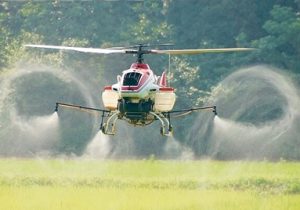
Source: (Staff, 2020)
The prevailing trend for drones is constant innovation and development for a specific purpose(s), whether for a specific job, defense, or nefarious purposes. Successful criminals and terrorist organizations typically dare to do something new, never seen before, to thwart or penetrate current defenses/security countermeasures. Nothing says an individual or group could not adapt current drone technologies to conduct acts of terror and coordinated offensive attacks on critical infrastructure or adversarial populations.
Examples of this could be combining an off-the-shelf drone aerosol delivery system such as an agricultural drone and filling its tanks with homemade chemical weapons like anthrax and ricin to spray low-yield toxins throughout a residential area. Another more recent military development would be through the use of ‘suicide drone’ technology to engage a point target or single building by flying into it with a chemical payload onboard.
Current models of off-the-shelf agriculture drones like the DJI Agri’s T30 can carry an eight-gallon payload. They can cover 40 acres per hour with obstacle avoidance and terrain following capabilities and a range of 3.1 miles from the operator. (Drones, 2022)
Figure 2.6 DJI Agri’s T30
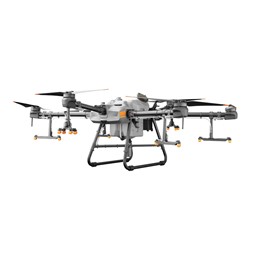
Source: (Drones, 2022)
A Parting Nightmare
Did you realize that “Drones are nothing more than small crop dusters and work silently, effectively as a deployment vehicle for chemical weapons? Think of it over every agricultural field – suicide drones avionics and programming in a crop-dusting platform!
Bibliography
Anthony Deutsch, R. (2018, April 16). Insider. Retrieved from the US Accuses Russia of possibly tampering with gas attacks evidence in Syria: https://www.businessinsider.com/us-says-russia-possibly-tampering-with-gas-attack-evidence-in-syria-2018-4.
Bowman, R. B. (2022, March 18). Breaking Defense. Retrieved from Ukraine is getting Switchblade. It should be just the first wave of loitering munitions for Kyiv: https://breakingdefense.com/2022/03/ukraine-is-getting-switchblade-it-should-be-just-the-first-wave-of-loitering-munitions-for-kyiv/.
Crumley, B. (2022, March 11). DroneDJ. Retrieved from Ukraine reportedly adapts small drones to drop Molotov cocktails in war with Russians: https://dronedj.com/2022/03/11/ukraine-reportedly-adapts-small-drones-to-drop-molotov-cocktails-in-war-with-russians/.
Details, F. a. (2012, July). Facts and Details. Retrieved from Chemical Weapons: https://factsanddetails.com/world/cat58/sub384/item2385.html
Drones, T. (2022, April). Talos Drones. Retrieved from DJI Agricultural Drones: https://talosdrones.com/product/buy-dji-agras-t30-sprayer-drone/
Emir, C. (2022, January 13). Interesting Engineering. Retrieved from interestingengineering.com: https://interestingengineering.com/the-most-brutal-mexican-cartel-used-drones-to-drop-bombs-on-their-rival
Feldscher, J. (2022, March 23). Defense One. Retrieved from Threats: Chemical Weapons a ‘Real Threat’ in Ukraine, Biden Says https://www.defenseone.com/threats/2022/03/chemical-weapons-real-threat-ukraine-biden-says/363523/.
Front, S. (2020, August 12). southfront.org. Retrieved from Russia Confirms Usage of Kalashnikov Kamikaze Drone ‘KUB-BLA’ in Syria: https://southfront.org/russia-confirms-usage-of-kalashnikov-kamikaze-drone-kub-bla-in-syria/.
HaberDergilik/Kara-birliklernin-silahi-havan-dronla-havlandi. (2022, March 20). Retrieved from ssdergilik.com: ssdergilik.com/tr/HbaerDergilik/Kara-birliklernin-silahi-havan-dronla-havanlandi
Inform Napalm. (2022, March 03). Retrieved from Russia Prepares to use Chemical Weapons in Ukraine: https://informnapalm.org/en/russia-prepares-to-use-chemical-weapons-against-ukraine/
Kesslen, B. (2022, March 10). Ukrainians develop a drone that drops Molotov cocktails. Retrieved from New York Post: https://nypost-com.cdn.ampproject.org/c/s/nypost.com/2022/03/10/ukrainians-develop-drone-that-drops-molotov-cocktails/amp/
Knight, W. (2022, March 2017). Wired. Retrieved from Russia’s Killer Drone in Ukraine Raises Fears About AI in Warfare: https://www.wired.com/story/ai-drones-russia-ukraine/.
Lee, R. (2022, March 14 ). Twitter. Retrieved from Twitter @RALee85: https://twitter.com/RALee85/status/1503494100233949190?ref_src=twsrc%5Etfw
Staff, A. (2020, February 04). AgAirupdate. Retrieved from Broad Acre Drone Spraying Unlikely: https://agairupdate.com/2020/02/04/broad-acre-drone-spraying-unlikely/
Stein, L. O. (2018, June 15). War on The Rocks. Retrieved from The Military Logic Behind Assad’s Use of Chemical Weapons: https://warontherocks.com/2018/06/the-military-logic-behind-assads-use-of-chemical-weapons/
Valpolini, P. (2020, February 2). European Defense Review Magazine. Retrieved from Switchblade 600, the new Medium Range Loitering Munition: https://www.edrmagazine.eu/switchblade-600-the-new-medium-range-loitering-munition
Ward, K. D. (2021, September). Arms Control Association. Retrieved from Syria, Russia. and the Global Chemical weapons Crisis: https://www.armscontrol.org/act/2021-09/features/syria-russia-global-chemical-weapons-crisis
Wolfe, F. (2019, February 21). Aviation Today. Retrieved from Russia Unveils KUB-BLA Kamikaze Drone at IDEX 2019: https://www.aviationtoday.com/2019/02/21/russia-unveils-kub-bla-kamikaze-drone-idex-2019/.

